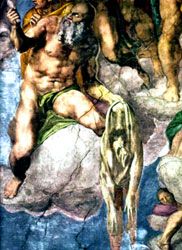
St. Bartholomew was one of the 12 Apostles of Jesus. Bartholomew (Greek Βαρθολομαιος) comes from the Aramaic bar-Tôlmay, meaning son of Tolmay or son of the furrows (perhaps a ploughman).
According to scripture, St. Bartholomew was one of the disciples to whom Jesus appeared at the Sea of Tiberias after the resurrection (John 21:2). He also witnessed the ascension (Acts 1:4, 12, 13).
Tradition has it that after the ascension, St. Bartholomew went on a missionary tour to India, where he left behind a copy of the Gospel of Matthew. In works of art he is often represented with a large knife, or, as in Michelangelo's Last Judgment, with his own skin hanging over his arm, tradition holds that in Armenia he was flayed alive and then crucified with his head upside down. This fate has led to him being adopted as the patron saint of tanners.
Source: Wikipedia.com
According to scripture, St. Bartholomew was one of the disciples to whom Jesus appeared at the Sea of Tiberias after the resurrection (John 21:2). He also witnessed the ascension (Acts 1:4, 12, 13).
Tradition has it that after the ascension, St. Bartholomew went on a missionary tour to India, where he left behind a copy of the Gospel of Matthew. In works of art he is often represented with a large knife, or, as in Michelangelo's Last Judgment, with his own skin hanging over his arm, tradition holds that in Armenia he was flayed alive and then crucified with his head upside down. This fate has led to him being adopted as the patron saint of tanners.
Source: Wikipedia.com
No comments:
Post a Comment